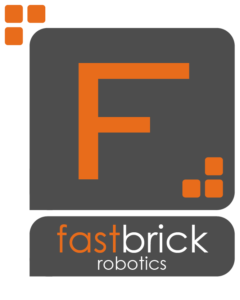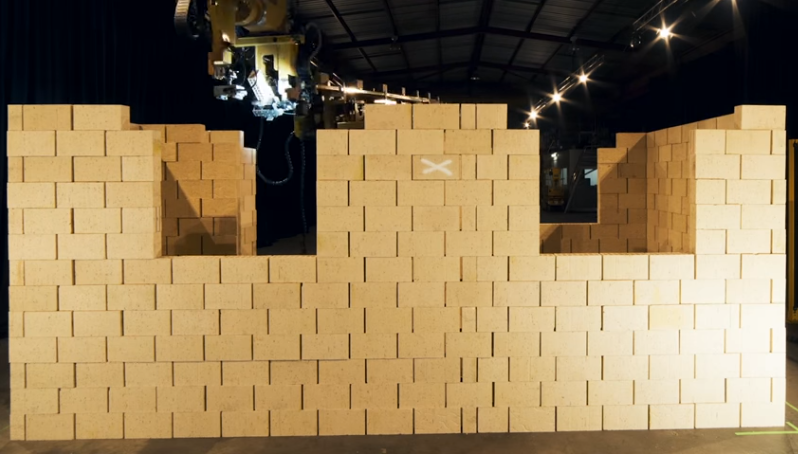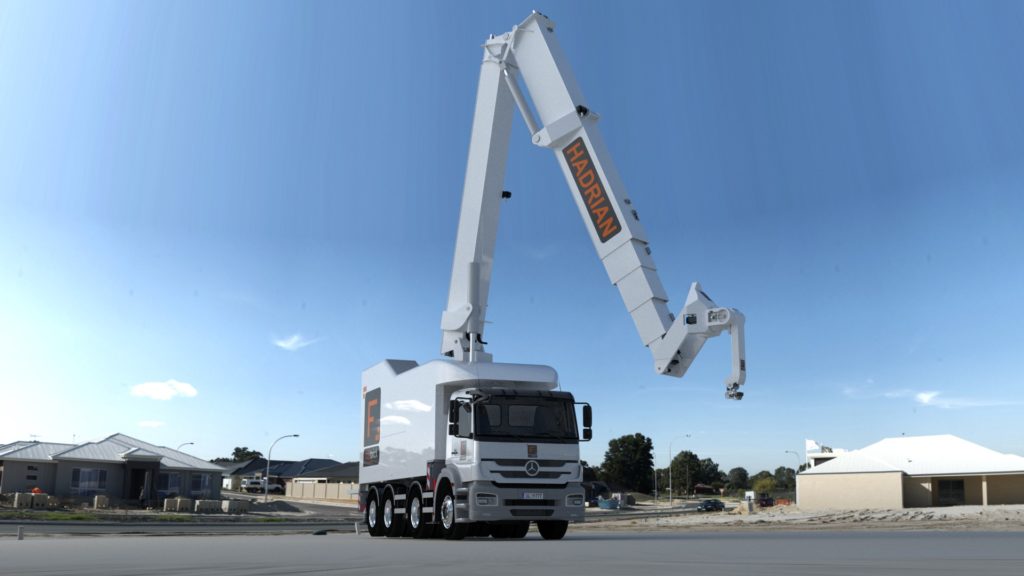Australian Company Fastbrick Robotics Introduces a Robot That Can Build a House 4X Faster than a Human
In the year 122, the Roman emperor Hadrian began building a stone wall that would eventually stretch more than 70 miles across Northern England. Constructed as a defensive fortification around the Roman-controlled province of Britannia, the wall took about six years to build; parts of it still stand and are a popular tourist attraction in England today.
Today, Hadrian’s namesake is building walls at a much faster rate – much faster than any human can, in fact. Hadrian 105 is a robot developed by Australian company Fastbrick Robotics, and it’s capable of laying bricks at a rate of 225 bricks per hour. For a human to lay that many bricks, it would take about half a day – and the Hadrian 105 is just a precursor for a much larger and faster robot to be named Hadrian X, which Fastbrick Robotics is currently working on.
The company describes the robots as “3D automated robotic bricklaying technology.” It’s not exactly the same as most 3D printing techniques we’re used to seeing, as the bricks are already made – no raw materials are being extruded or sintered. It does meet the definition of additive manufacturing, though, as material is being deposited, one layer at a time, following a computer aided design.
“From the computer aided design ( CADCAM ) of a house structure, this 3D robotic end to end bricklaying system handles the automatic loading cutting, routing and placement of all the bricks course by course. The high level accuracy of the finished product allows following trades to pre-fabricate from the CAD design then simply install,” Fastbrick Robotics describes on its website.
The whole process is automated. Bricks are fed onto a conveyor belt that travels along a long robotic arm, or telescopic boom. The bricks travel along the boom and are gripped by a clawlike device that lays them out methodically, directed by a laser guiding system. Until the brick shell is finished and the house’s other elements need to be added, the structure never needs to be touched by human hands.
There are a lot of advantages to such a system – reduced time, reduced cost, and reduced waste, plus improved safety. The adjustable arm can accommodate bricks of any size, and it’s extremely accurate. The Hadrian X is expected to drastically improve upon the current model, too, with a bricklaying speed of 1,000 bricks per hour. All necessary materials will be delivered to the building site on a truck attached to the robotic arm.
“We are a frontier technology company, and we’re one step closer to bringing fully automated, end-to-end 3D printing brick construction into the mainstream,” said Fastbrick CEO Mike Pivac. “We’re very excited to be taking the world-first technology we proved with the Hadrian 105 demonstrator and manufacturing a state-of-the-art machine.”
Fastbrick Robotics plans to commercialize their patented technology, and they’re also developing an add-on for SOLIDWORKS software that uses 3D model data to create machine code for the size, cut, rotation and placement of the bricks.
 It hasn’t been long at all since 3D printed buildings were being talked about as something that would happen in the distant future, but it seems as though they became a reality almost overnight. A Chinese construction company recently 3D printed an entire two-story house in a mere 45 days, and the first 3D printed office building, constructed in 17 days, was recently unveiled in Dubai. An engineer 3D printed a tiny house in 24 hours, and a municipality in Italy is currently working on 3D printing an entire village. Not only are 3D printed buildings suddenly here, but the methods of printing them are as varied as the people that design them. Fastbrick Robotics brings yet one more new form of additive manufacturing that could quickly transform the construction industry into something very different, and more effective, than we’ve ever seen before. Is this is a mode of construction you would be interested in using? Let’s discuss in the 3D Automated Robotics Bricklaying Technology forum over at 3DPB.com.
It hasn’t been long at all since 3D printed buildings were being talked about as something that would happen in the distant future, but it seems as though they became a reality almost overnight. A Chinese construction company recently 3D printed an entire two-story house in a mere 45 days, and the first 3D printed office building, constructed in 17 days, was recently unveiled in Dubai. An engineer 3D printed a tiny house in 24 hours, and a municipality in Italy is currently working on 3D printing an entire village. Not only are 3D printed buildings suddenly here, but the methods of printing them are as varied as the people that design them. Fastbrick Robotics brings yet one more new form of additive manufacturing that could quickly transform the construction industry into something very different, and more effective, than we’ve ever seen before. Is this is a mode of construction you would be interested in using? Let’s discuss in the 3D Automated Robotics Bricklaying Technology forum over at 3DPB.com.
Watch the Hadrian 105 below in a time-lapse of building action:
Subscribe to Our Email Newsletter
Stay up-to-date on all the latest news from the 3D printing industry and receive information and offers from third party vendors.
You May Also Like
3D Printing Unpeeled: Biofuel Waste to Filament & Sustainable Photopolymers
I can’t ever remember a day with so many potentially high impact news stories have come out. In one story, we all know that there are problems with the safety...
Finnair Hires AM Craft to 3D Print Plastic Parts for Aircraft Interiors
Riga-based AM Craft, a supplier specialized in 3D printing aviation components and certified under EASA Part 21G, announced a significant achievement today. The company will assist in upgrading Finnair’s A320...
3DPOD Episode 198: High Speed Sintering with Neil Hopkinson, VP of AM at Stratasys
Neil Hopkinson, a pioneering 3D printing researcher, played a pivotal role in developing a body of research that is widely utilized today. He also invented High Speed Sintering (HSS), also...
3D Printing Webinar and Event Roundup: May 12, 2024
Webinars and events are picking up in the AM industry this week! ASTM International continues its Professional Certificate Course and Stratasys continues its advanced in-person trainings, while 3D Systems is...



































